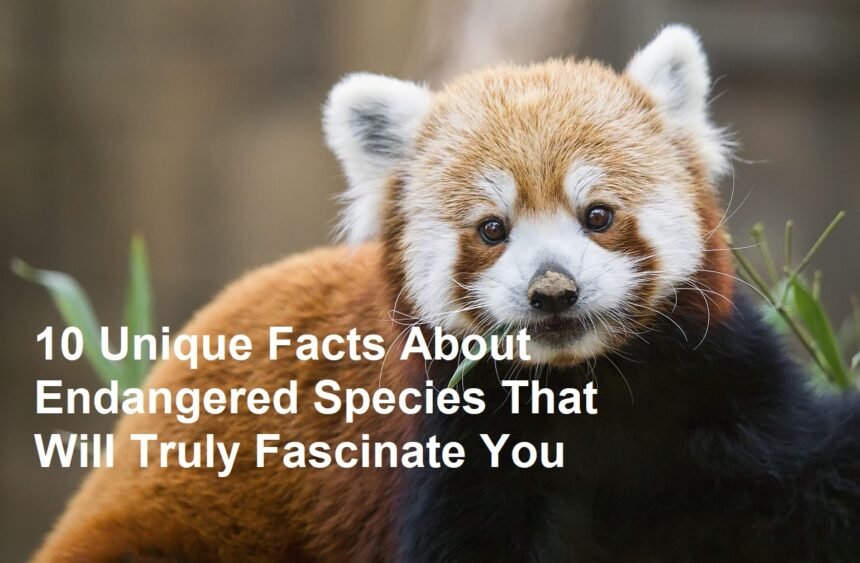When we hear the term endangered species, most of us immediately think of pandas or tigers. But did you know that there are thousands of species quietly struggling for survival, each with incredible traits and surprising facts? This article will dive into Unique Facts About Endangered Species That Will Truly Fascinate You —10 facts that are not only jaw-dropping but also highlight why these animals matter.
Whether you’re a nature lover, a student, or just someone curious about the world, this list will leave you both amazed and more aware of what’s at stake.
Why Knowing These Facts Matters
Understanding the Facts About Endangered Species is more than trivia. It helps raise awareness, inspires action, and shows the beauty and complexity of life on Earth. The more we learn, the more we can do to protect them.
Let’s jump in.
1. The Kakapo Is the World’s Only Flightless Parrot
Native to New Zealand, the kakapo is not only flightless—it’s also nocturnal and smells like sweet flowers (a trait that unfortunately makes it easy for predators to find).
There are fewer than 250 individuals left, but thanks to ongoing conservation and research, numbers are slowly rising. According to peneliti para ahli terhadap Spesies yang Terancam Punah, every individual kakapo is tracked with high-tech devices!
- The Javan Rhino Lives in Just One Place on Earth
The Javan rhino, once widespread in Southeast Asia, now only exists in one place: Ujung Kulon National Park in Indonesia. There are only around 80 individuals left, making it one of the rarest large mammals on the planet.
Conservation efforts include 24/7 monitoring, strict protection, and habitat restoration.
3. The Axolotl Can Regrow Its Own Brain
Yes, you read that right. The adorable axolotl, a type of salamander from Mexico, can regenerate limbs, spinal cords, and even parts of its brain!
Unfortunately, pollution and invasive species have placed the axolotl on the endangered species list. Researchers are studying its incredible regeneration abilities for potential medical breakthroughs.
4. Penguins in Africa? Meet the African Penguin
Most people associate penguins with ice and snow, but the African penguin lives on warm beaches from Namibia to South Africa. It’s also known for its donkey-like braying sound.
This unique penguin is endangered due to overfishing, oil spills, and climate change. Organizations are working hard to rescue abandoned chicks and protect nesting grounds.
5. The Mary River Turtle Breathes Through Its Butt
This rare Australian turtle, also known as the “punk turtle” for the algae that grows on its head, has a bizarre talent: it can breathe through specialized organs in its cloaca (yes, that’s near its rear end).
It’s endangered because of river damming and the pet trade. Fun fact: the species wasn’t formally identified by scientists until the 1990s—even though it had been kept as a pet for decades!
6. Sharks Are Older Than Trees
Some shark species have been swimming through Earth’s oceans for over 400 million years, which means they’ve been around longer than trees!
Despite their long history, many sharks are now endangered due to overfishing and the shark fin trade. According to peneliti para ahli terhadap Spesies yang Terancam Punah, some populations have declined by over 90% in the past few decades.
7. Elephants Can Recognize Themselves in a Mirror
This might sound simple, but mirror recognition is considered a sign of high intelligence. Very few animals can do this, and elephants are one of them.
Sadly, African and Asian elephants are endangered due to habitat loss and poaching. Conservationists are using satellite tracking and anti-poaching patrols to protect these gentle giants.
8. Some Frogs Freeze Solid and Come Back to Life
The wood frog, found in Alaska, has a superpower—it freezes solid in winter, with no heartbeat or brain activity, and then thaws out in spring like nothing happened.
While this frog isn’t endangered, many frog species around the world are due to disease, climate change, and deforestation. Amphibians are often early indicators of environmental health.
9. The Vaquita May Be the Rarest Marine Mammal
The vaquita, a small porpoise found only in Mexico’s Gulf of California, is critically endangered—with fewer than 10 individuals believed to be alive today.
Its biggest threat is getting caught in illegal fishing nets. Conservationists and local communities are racing against time to prevent its extinction.
10. Red Pandas Are Not Related to Giant Pandas
Despite the name, red pandas are not closely related to giant pandas. They’re actually in their own unique family and are more closely related to raccoons and weasels.
They live in the Himalayas and eat mostly bamboo. Red pandas are endangered due to habitat loss and illegal pet trade. Their numbers in the wild are estimated to be under 10,000.
What Experts Say: Expert Research on Endangered Species
Researchers and scientists around the globe are constantly studying endangered species to understand their behavior, genetics, and habitats. This research is critical for developing effective conservation strategies.
For example:
- Genetic studies help with breeding programs in zoos and reserves.
- Camera traps and satellite collars track animal movements to protect them from poachers.
- Local education programs help reduce conflict between people and wildlife.
In short, every fact we learn helps us protect these animals more effectively.
How You Can Help Protect Endangered Species
Knowing these fascinating facts is just the first step. Here’s how you can take action today:
Support Conservation Organizations
Donate to or volunteer with groups working on wildlife conservation in your country or internationally.
Shop Responsibly
Avoid buying products made from animal parts, exotic pets, or items that contribute to habitat destruction (like palm oil from unsustainable sources).
Spread Awareness
Share articles like this one, support documentaries, and talk to friends and family about why endangered species matter.
Advocate for Policy
Support legislation that protects wildlife and penalizes poachers or illegal traders.
Final Thoughts
Nature is full of wonders—and these 10 unique facts about endangered species prove just how amazing and diverse life on Earth really is. But behind every surprising fact is a real and urgent story of survival.
If we don’t act, many of these animals may disappear forever. But with the help of researchers, conservationists, and everyday people like you, there’s still hope.
What Do You Think?
Which of these facts surprised you the most? Do you have a favorite endangered species?
Leave a comment, share this post, and join the movement to protect these incredible creatures before it’s too late.
Let’s keep the magic of nature alive—one species at a time.












